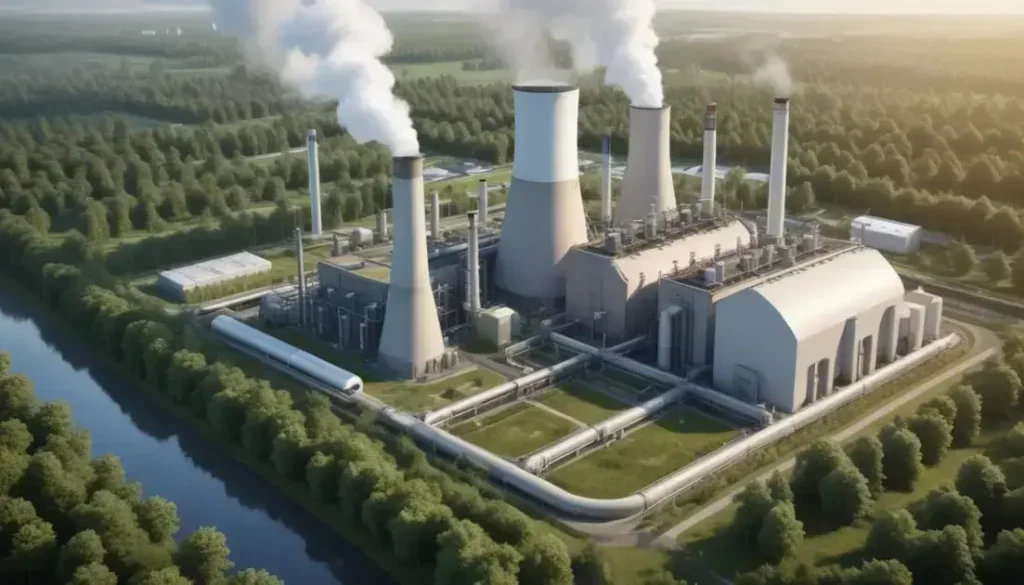Hydrogen helicopters represent a pioneering advancement in aviation, offering zero-emission flights that significantly reduce carbon footprints while paving the way for sustainable air travel through the adoption of hydrogen fuel technology and infrastructure development.
The debut of hydrogen helicopters marks a groundbreaking evolution in aviation. These innovative machines promise to redefine the industry, creating excitement about sustainable transport options. Ever wondered how this can affect businesses in India? Let’s explore!
Introduction to hydrogen helicopters
Hydrogen helicopters are at the forefront of aviation innovation, offering a promising solution to the challenges of pollution and climate change. These helicopters operate on hydrogen fuel cells, emitting only water vapour as a byproduct. The transition to hydrogen-based technology represents a significant step towards sustainable aviation.
One key advantage of hydrogen helicopters is their potential for reduced carbon emissions. As countries move towards stricter environmental regulations, the adoption of hydrogen technology positions companies to comply and thrive in a greener market. The aviation industry contributes significantly to greenhouse gas emissions, and shifting to hydrogen can substantially cut this footprint.
Moreover, the infrastructure for hydrogen production and distribution is evolving. Governments and private firms are investing heavily in creating a robust supply chain for hydrogen, which will enable smoother operations for these advanced helicopters. Facilities supporting hydrogen refuelling are being planned alongside traditional airports, facilitating a seamless transition for operators.
The operational range and efficiency of hydrogen helicopters also make them a viable replacement for conventional aircraft in various applications, including emergency medical services and cargo transport. As technology advances, the cost of hydrogen production is expected to decrease, making this innovative aviation solution more accessible for Indian firms and enhancing their competitiveness in the global market.
Historical context of aviation and sustainability
The journey of aviation has always intertwined with the quest for sustainability. Historically, the aviation industry has faced scrutiny due to its significant contributions to carbon emissions. As air travel became increasingly popular in the 20th century, the environmental impact grew, leading to an urgent need for greener solutions.
In recent decades, the focus on sustainability has gained momentum. The development of fuel-efficient aircraft and alternative fuels has been a response to growing environmental awareness. Innovations such as biofuels and electric aircraft are now at the forefront of efforts to reduce the industry’s carbon footprint.
Global agreements, like the Paris Agreement, have further catalysed this shift. They encourage nations to commit to reducing greenhouse gas emissions, pushing the aviation sector towards adopting sustainable technologies. Countries across the world are investing in research and development to transition towards eco-friendly aviation practices.
Moreover, the integration of sustainability into aviation policies has led to new regulations on emissions and noise pollution. The aim is to not only mitigate the environmental impact but also foster a culture of responsibility within the aviation community. Recognising the historical context of these changes allows us to appreciate the significant strides being made in the pursuit of greener aviation solutions.
Technical specifications of the R44 hydrogen helicopter
The R44 hydrogen helicopter represents a revolutionary advancement in aviation technology, aiming to significantly reduce environmental impact. This aircraft is powered by hydrogen fuel cells, which provide clean energy without harmful emissions. The fuel cells convert hydrogen into electricity, enabling the helicopter to operate efficiently and quietly.
One of the standout features of the R44 is its lightweight composite body, designed specifically to enhance performance and reduce energy consumption. This aerodynamic structure facilitates optimal flight characteristics, improving both speed and maneuverability.
In terms of capacity, the R44 can comfortably accommodate up to four passengers, making it suitable for various applications, from recreational flights to emergency medical services. Its range extends up to 400 kilometers on a single fueling, showcasing its practicality for regional operations.
Moreover, the helicopter’s advanced avionics system includes state-of-the-art navigation and safety features, ensuring smooth and safe flights even in challenging conditions. This integration of innovative technology aims to not only enhance performance but also bolster the pilot’s situational awareness.
As part of a broader transition towards sustainable aviation, the R44 hydrogen helicopter sets a benchmark in the industry, combining advanced technology with environmental responsibility, paving the way for future developments in eco-friendly air travel.
Project Proticity and its goals
Project Proticity is a pioneering initiative aimed at advancing hydrogen technology in aviation. The project focuses on developing a sustainable framework for hydrogen-powered aircraft, including helicopters. By harnessing the potential of hydrogen as a clean fuel source, Proticity aims to significantly reduce the aviation industry’s environmental impact.
One of the primary goals of Project Proticity is to facilitate the adoption of renewable energy in flight systems. This initiative seeks to collaborate with various stakeholders, including government entities, research institutions, and private companies. By creating partnerships, Proticity aims to accelerate innovation and bring hydrogen solutions to the market more effectively.
The project also emphasizes the establishment of infrastructure needed for hydrogen production and distribution. Reliable refueling stations must be developed to support the increasing number of hydrogen-fueled aircraft, ensuring accessibility and convenience for operators.
Alongside technological advancements, Project Proticity is committed to addressing safety regulations associated with hydrogen use in aviation. Developing stringent guidelines will help build confidence among operators and regulators, paving the way for widespread acceptance of hydrogen technologies. By achieving these objectives, Project Proticity hopes to set a benchmark for sustainable practices within the aviation sector.
Impact on organ transport logistics
The integration of hydrogen helicopters in organ transport logistics holds transformative potential for the medical field. Speed and efficiency are critical when it comes to delivering organs, and hydrogen-powered helicopters offer significant advantages over traditional methods. With their advanced technology, these helicopters can reduce travel time, ensuring that vital organs reach their destinations faster.
One key benefit of using hydrogen helicopters is their ability to operate in various environments, including remote and difficult-to-access locations. This capability allows hospitals and organ procurement organizations to expand their reach, ultimately increasing the number of successful transplants. The zero-emission aspect of hydrogen technology also aligns with the growing emphasis on sustainability in healthcare.
Moreover, the enhanced cargo capacity of these helicopters enables medical teams to transport not only the organs but also the necessary medical equipment. This ensures that all supplies needed for successful procedures arrive together, streamlining the transport process and improving patient outcomes.
As hydrogen infrastructure develops, the reliability and convenience of these helicopters in organ transportation are expected to grow. It signifies a new era where the logistics surrounding organ transplants can become more efficient, potentially saving more lives. The implications of this technology on healthcare logistics highlight the important intersection of innovation and human need.
Challenges for hydrogen aviation infrastructure
The development of hydrogen aviation infrastructure faces several significant challenges that must be addressed to enable the widespread adoption of hydrogen-powered aircraft. One major obstacle is the production and availability of hydrogen fuel. Currently, most hydrogen is produced using fossil fuels, which undermines the environmental benefits of hydrogen technology. Transitioning to green hydrogen production methods requires significant investment and innovation.
Another challenge is the lack of refuelling stations equipped for hydrogen. Existing aviation infrastructure primarily supports traditional fuels, making it essential to establish a comprehensive network of hydrogen refuelling facilities. This network must be strategically located to support efficient operation of hydrogen-powered aircraft, particularly for regional flights.
Safety considerations are also paramount in the adoption of hydrogen aviation. Hydrogen is highly flammable, necessitating stringent safety protocols and regulations to prevent accidents. Building confidence among stakeholders, including airlines and regulatory bodies, will be critical to overcoming these concerns.
Furthermore, the financial investment required for transitioning to hydrogen infrastructure can be substantial. Both public and private sectors need to collaborate on funding these initiatives, as the high upfront costs may deter potential investors. Addressing these challenges is vital to unlocking the full potential of hydrogen aviation and contributing to a more sustainable future for the industry.
Regulatory insights on hydrogen use
The regulatory landscape surrounding hydrogen use in aviation is evolving rapidly as governments and organizations recognize the potential of hydrogen technology. Regulations are essential to ensure safety, environmental integrity, and to facilitate widespread adoption of hydrogen-powered aircraft. Key regulatory bodies are actively working to develop comprehensive guidelines that govern hydrogen production, storage, and transport.
One important aspect of these regulations is safety standards. Hydrogen is highly flammable, necessitating stringent safety measures to mitigate risks associated with leaks and fires. Regulatory authorities are focused on establishing protocols that address these safety concerns, including the design of hydrogen handling infrastructure and training for personnel involved in operations.
Another critical element is environmental compliance. Governments are keen on ensuring that hydrogen production aligns with sustainability goals. This involves promoting green hydrogen production methods and regulating the carbon footprint of hydrogen-related activities to avoid undermining the environmental benefits of hydrogen aviation.
Additionally, international cooperation is vital. As hydrogen technology crosses borders, aligning regulations among various countries can streamline approvals and foster innovation. Multinational discussions and collaborations are essential in developing standardized regulations that support the safe and effective integration of hydrogen into the global aviation industry, paving the way for a sustainable future.
Environmental benefits of hydrogen fuel
Hydrogen fuel offers numerous environmental benefits that position it as a key player in the transition towards more sustainable energy solutions. One of the most significant advantages is that hydrogen produces zero harmful emissions when used as a fuel source. Instead of releasing carbon dioxide or other pollutants, hydrogen fuel emits only water vapour, contributing to cleaner air and a reduction in greenhouse gas levels.
Switching to hydrogen can drastically reduce the carbon footprint of the aviation industry. Traditional fuels used in aviation are major contributors to global warming. By replacing these fuels with hydrogen, emissions from aircraft can be significantly lowered, making a substantial contribution to climate change mitigation efforts.
In addition to reducing emissions, hydrogen can be produced using renewable energy sources, such as wind or solar power. This process, known as green hydrogen production, further enhances the environmental profile of hydrogen fuel. By leveraging abundant renewable energy, we can create a sustainable cycle of energy production and consumption.
Utilizing hydrogen as a fuel also promotes energy security, decreasing dependence on fossil fuels, which often have fluctuating prices and contribute to geopolitical tensions. As countries pursue energy independence, hydrogen presents a viable alternative, fostering a cleaner and more sustainable future for all.
Future of zero-emission air travel
The future of zero-emission air travel is bright, driven by technological advancements and a global commitment to sustainability. The introduction of hydrogen-powered aircraft and electric planes marks a significant shift in aviation, focusing on reducing the environmental impact of air travel. These innovations promise to eliminate harmful emissions, paving the way for a cleaner, greener future.
As more countries implement stringent environmental regulations, the demand for zero-emission solutions in aviation will grow. This demand will encourage manufacturers to invest in research and development, leading to enhanced performance and efficiency of green aircraft. Moreover, the collaboration between governments, aerospace companies, and energy providers is crucial in developing a robust infrastructure to support zero-emission flights.
Technologically, advancements in battery and fuel cell technologies will play a pivotal role. Improved energy density and faster charging times will make electric aircraft more viable for commercial use. In parallel, the scaling of hydrogen production, especially through renewable sources, will ensure a consistent supply of clean fuel for future air travel.
Additionally, the rising awareness among travelers regarding sustainability will drive airlines to adopt zero-emission technologies. As consumers increasingly prefer eco-friendly options, airlines that prioritize green technology will enhance their market competitiveness. The vision for zero-emission air travel is not just a dream; it is becoming a reality, setting the stage for a transformative era in aviation.
Comparison with traditional aviation fuels
When comparing hydrogen fuel with traditional aviation fuels, several key differences emerge that highlight hydrogen’s potential for revolutionizing air travel. Traditional aviation fuels, such as kerosene, are derived from fossil fuels and release significant amounts of carbon dioxide and other pollutants during combustion. In contrast, hydrogen fuel, when utilized in aviation, produces only water vapour, making it a significantly cleaner alternative.
Another vital aspect of comparison is energy density. While traditional aviation fuels provide a high energy content per unit volume, hydrogen has a lower volumetric energy density. However, when stored as a liquid, hydrogen can offer a comparable energy density, enabling longer flight ranges. With advancements in storage technology, hydrogen can effectively compete with conventional fuels for long-haul flights.
Moreover, the production of traditional fuels has substantial environmental impacts. Extraction and refining processes contribute to habitat destruction and greenhouse gas emissions. Conversely, hydrogen can be produced from renewable sources like wind and solar energy through the process of electrolysis, promoting a more sustainable energy landscape.
In terms of infrastructure, airports are predominantly equipped for conventional fuels, posing a challenge for the integration of hydrogen. Developing the necessary infrastructure for hydrogen refuelling will require collaboration between industry stakeholders and regulatory bodies. Nonetheless, the shift towards hydrogen fuels may lead to a cleaner and more sustainable future for aviation.
Case studies of successful hydrogen innovations
Exploring case studies of successful hydrogen innovations reveals the transformative potential of hydrogen technology across various sectors, particularly in aviation. One notable example is the development of the world’s first hydrogen-powered passenger aircraft by a pioneering European aerospace company. This aircraft integrates hydrogen fuel cells, enabling zero-emission flight while maintaining impressive range and efficiency.
Another significant case study involves a successful collaboration between a major airline and a renewable energy provider. Together, they developed an innovative refuelling system that utilizes green hydrogen, produced through renewable energy sources. This partnership not only reduces the environmental impact of the airline’s operations but also sets a benchmark for sustainable practices in the industry.
In the automotive sector, hydrogen innovations have led to the creation of versatile fuel cell vehicles. These vehicles, ranging from buses to trucks, showcase hydrogen’s capability to serve as a clean fuel alternative. Governments worldwide are investing in infrastructure development, including hydrogen refuelling stations, to support this initiative and enhance market adoption.
Such case studies emphasize that hydrogen is not just a concept but a reality with practical applications that are advancing rapidly. These successes highlight the importance of continued investment and innovation in hydrogen technology, paving the way for a sustainable future in transportation.
Conclusion and future outlook for Indian businesses
The transition to hydrogen-powered aviation presents a unique opportunity for Indian businesses to lead in sustainable practices. As the global demand for eco-friendly technologies increases, Indian aviation firms can leverage hydrogen innovations to enhance their competitiveness in the market. This shift not only aligns with global sustainability goals but also caters to the growing consumer preference for green alternatives.
Investing in hydrogen infrastructure can position Indian companies at the forefront of this emerging sector. By collaborating with technology providers and government agencies, these businesses can develop the necessary systems for hydrogen production, storage, and refuelling. Such initiatives will enhance operational efficiency and create pathways for job growth in green sectors.
Moreover, the Indian government’s focus on promoting clean energy sources through policies and incentives will boost the hydrogen economy. As regulations evolve, companies adopting hydrogen technologies will benefit from competitive advantages, including reduced operational costs and improved public perception.
In conclusion, the future of hydrogen in aviation offers promising prospects for Indian businesses. Embracing this change not only contributes to environmental sustainability but also drives economic growth and innovation, ensuring that Indian firms play a pivotal role in the global transition to a low-carbon economy.
Looking Ahead: Embracing Hydrogen in Aviation
The shift towards hydrogen-powered aviation represents a significant opportunity for Indian businesses to lead the way in sustainability. By adopting hydrogen technologies, companies can reduce their environmental impact and meet the growing demand for cleaner air travel.
Investing in infrastructure, collaborating with key stakeholders, and embracing innovation will be crucial in realizing this potential. Success stories from around the world demonstrate that sustainable practices not only protect the environment but also drive economic growth.
As the aviation industry evolves, Indian businesses that proactively engage with hydrogen solutions will position themselves for success in the future. With the right strategies and investments, the dream of zero-emission air travel can become a reality.
In summary, the future is bright for hydrogen aviation, and it’s time for Indian firms to seize this moment to revolutionize the industry.
Frequently Asked Questions
What are the benefits of using hydrogen fuel in aviation?
Hydrogen fuel significantly reduces carbon emissions, producing only water vapour as a byproduct. This makes air travel cleaner and more sustainable.
How does hydrogen compare to traditional aviation fuels?
Hydrogen has the potential for zero emissions, while traditional fuels release harmful pollutants. Although hydrogen requires new infrastructure, it offers a cleaner alternative.
What advancements are needed for hydrogen aviation to succeed?
Improvements in hydrogen production, storage technology, and refuelling infrastructure are crucial. Additionally, safety regulations must be established to facilitate its use in aviation.
How can Indian businesses benefit from adopting hydrogen technologies?
By investing in hydrogen aviation, Indian businesses can align with global sustainability goals, enhance competitiveness, and potentially open new markets in the green economy.
What role do governments play in promoting hydrogen aviation?
Governments can support hydrogen aviation through policies, funding for infrastructure, and regulations that promote the development and adoption of hydrogen technologies.
Are there any successful examples of hydrogen innovations in aviation?
Yes, several companies are developing hydrogen-powered aircraft, demonstrating the feasibility of this technology. Collaborations between airlines and energy providers are also paving the way for successful hydrogen refuelling systems.


